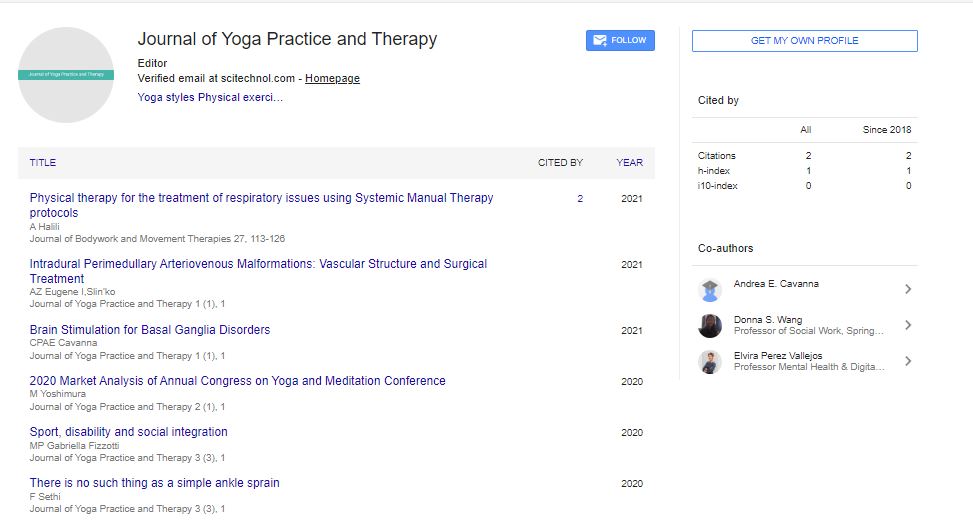Perspective, J Yoga Therap Vol: 6 Issue: 4
Hatha Yoga: Foundational Practice for Physical Postures, Breath Control
Kuptniratsaikul Suesuwan*
1Department of Rehabilitation Medicine, Mahidol University, Bangkok, Thailand
*Corresponding Author: Kuptniratsaikul Suesuwan,
Department of Rehabilitation
Medicine, Mahidol University, Bangkok, Thailand
E-mail: kusuesuwan@gmail.com
Received date: 24 November, 2023, Manuscript No. JYPTY-24-124125;
Editor assigned date: 28 November, 2023, Pre QC No. JYPTY-24-124125 (PQ);
Reviewed date: 14 December, 2023, QC No. JYPTY-24-124125;
Revised date: 21 December, 2023, Manuscript No. JYPTY-24-124125 (R);
Published date: 28 December, 2023, DOI: 10.4172/JYPTY.1000136
Citation: Suesuwan K (2023) Hatha Yoga: Foundational Practice for Physical Postures, Breath Control, and Me. Int J Yoga Therap 6:4.
Description
In the vast landscape of yoga traditions, Hatha Yoga stands as a timeless and foundational practice that intertwines physical postures, breath control, and meditation. This manuscript delves into the essence of Hatha Yoga, unraveling its origins, principles, and the myriad benefits it offers to individuals seeking holistic well-being.
The roots of hatha yoga
Historical origins: Hatha Yoga traces its roots to ancient India, with its origins embedded in the early yogic scriptures such as the Hatha Yoga Pradipika. Developed as a means to prepare the body for extended periods of meditation, Hatha Yoga emerged as a comprehensive system that balances physical postures (asanas) and breath control (pranayama).
Philosophical foundation: At its core, Hatha Yoga embodies the broader philosophy of yoga, aiming to create harmony between the body, mind, and spirit. The word "Hatha" itself signifies the union of opposites-sun (ha) and moon (tha), symbolizing the integration of dualistic forces within.
The practice of hatha yoga asanas
Physical postures (asanas): Hatha Yoga places a strong emphasis on physical postures designed to enhance strength, flexibility, and balance. Asanas range from gentle stretches to more challenging poses, providing practitioners with a diverse toolkit to cultivate a resilient and supple body.
Alignment and mindful movement: The practice of Hatha Yoga encourages mindful movement and precise alignment. Each posture is an opportunity for self-discovery, as practitioners learn to tune into the subtle sensations of the body, fostering a deep connection between movement and breath.
Pranayama-the breath of life
Breath control (pranayama): Integral to Hatha Yoga is the practice of pranayama, or breath control. Through specific breathing techniques, practitioners harness the life force (prana) to energize the body, calm the mind, and enhance overall well-being. Pranayama serves as a bridge between the physical and the mental aspects of the practice.
Balancing energies: Pranayama in Hatha Yoga is designed to balance the two primary energy channels-ida and pingala-symbolizing the feminine and masculine aspects within. The harmonization of these energies leads to a state of equilibrium and centeredness.
The therapeutic benefits of hatha yoga
Physical well-being: Hatha Yoga, with its emphasis on physical postures, contributes significantly to overall physical health. Regular practice can improve flexibility, enhance muscular strength, and promote better posture, reducing the risk of musculoskeletal issues.
Stress reduction and mental clarity: The mindful nature of Hatha Yoga fosters mental clarity and stress reduction. The synchronized flow of breath and movement creates a meditative space, allowing practitioners to release tension, calm the mind, and cultivate a sense of inner peace.
Improved respiratory function: Pranayama practices in Hatha Yoga focus on conscious breathing, which, over time, enhances respiratory function. Deep and intentional breathing not only oxygenates the body but also promotes lung capacity and respiratory efficiency.
Enhanced mind-body connection: The integration of physical postures and breath awareness in Hatha Yoga deepens the mind-body connection. This heightened awareness encourages individuals to become attuned to their bodies, promoting a sense of self-awareness that extends beyond the mat.
Hatha yoga in modern context
Adaptability for all levels: One of the remarkable aspects of Hatha Yoga is its adaptability. Whether practiced by beginners or seasoned yogis, Hatha Yoga can be modified to suit various fitness levels and physical conditions. Its inclusivity makes it accessible to a broad spectrum of individuals.
Complementary to other practices: Hatha Yoga serves as a foundation for various yoga styles and complements other physical activities. Its principles are often woven into modern fitness routines, rehabilitation programs, and even incorporated into holistic wellness approaches.
Conclusion
Hatha Yoga, with its centuries-old wisdom and time-tested practices, stands as a beacon of holistic well-being. Beyond the physical postures and breath techniques, it offers a pathway to selfdiscovery, balance, and a harmonious integration of body and mind. As individuals embrace Hatha Yoga, they embark on a transformative journey-one that extends beyond the confines of a yoga mat and becomes a way of life. In the gentle flow of asanas and the rhythmic dance of breath and movement, practitioners find not only physical vitality but also mental clarity, emotional balance, and a profound sense of interconnectedness with the vast tapestry of existence. Hatha Yoga, in essence, invites individuals to step onto the path of self-discovery, cultivating a life imbued with resilience, mindfulness, and enduring well-being.
 Spanish
Spanish  Chinese
Chinese  Russian
Russian  German
German  French
French  Japanese
Japanese  Portuguese
Portuguese  Hindi
Hindi 